Port of Huelva
The Port of Huelva is a cargo and fishing port located off the Spanish southwestern coast, belonging to the municipalities of Huelva and Palos de la Frontera. With a total annual traffic capacity of 33.8 million tonnes, it is the second biggest port in Andalusia after the Port of Algeciras.
| Port of Huelva | |
|---|---|
 | |
| Location | |
| Country | Spain |
| Location | Huelva, Palos de la Frontera |
| Coordinates | 37.198685°N 6.937533°W |
| UN/LOCODE | ESHUV[1] |
| Details | |
| Operated by | Port Authority of Huelva |
| Statistics | |
| Annual cargo tonnage | 33.8 million tonnes (2019)[2] |
| Annual container volume | 70,852 TEU (2019)[2] |
Description
The port is located in the estuary formed by the Odiel and Río Tinto rivers.[3] It is operated by the Port Authority of Huelva.[4]
Rich in metals, the Huelva region was known to be an exporter of silver already in Antiquity in the context of the "Tartessos" culture.[5] The mining activity was resumed by the Romans.[5]
The precursor of the current Port Authority of Huelva, the Junta Especial de Comercio y Puerto de Huelva, was created on 8 December 1873,[6] during a period of resurgence of the mining activity in the province of Huelva thanks to the injection of foreign capital and technology.[5]
In the 1960s much of the activity was moved to the Puerto Exterior, located in Palos de la Frontera, more apt for ships with greater draft:[7] as it was passed the project for a mineral loading dock and an oil dock in Torre Arenilla in 1963, the Levante dock (in the Puerto Interior) was mostly left for fishing,[8] specializing in the commercialization of frozen fish.[7]
Statistics
Freight volume:[9]
| Year | Freight traffic (Tn) | Liquid bulk (Tn) | Solid bulk (Tn) | Other (Tn) | Containers (TEU) |
|---|---|---|---|---|---|
| 2013 | 26,369,503 | 21,488,718 | 4,145,909 | 137,783 | 3,116 |
| 2014 | 27,246,080 | 21,863,372 | 4,662,814 | 197,759 | 5,774 |
| 2015 | 27,375,435 | 21,598,676 | 5,137,350 | 159,384 | 7,834 |
| 2016 | 30,557,171 | 24,136,062 | 5,759,383 | 175,943 | 11,822 |
| 2017 | 32,332,572 | 24,904,547 | 6,487,378 | 155,200 | 58,916 |
| 2018 | 32,966,864 | 25,119,931 | 6,662,399 | 199,780 | 70,288 |
References
- "UNLOCODE (ES) - SPAIN". service.unece.org. Retrieved 28 April 2020.
- "El puerto de Huelva bate un nuevo récord en 2019 con 33,8 millones de toneladas, un 2,5% más que en 2018". Europa Press. 21 January 2020.
- Ruiz Romero de la Cruz 2004, p. 11.
- Couceiro Martínez & Serrano Pérez 2013, p. 12.
- Mojarro Bayo & Romero Macías 2012, p. 3.
- Mojarro Bayo & Romero Macías 2012, p. 7.
- Mojarro Bayo, Ana María (18 June 2012). "Historia". Puerto de Huelva.
- Ruiz Romero de la Cruz 2004, p. 12.
- "El Puerto en cifras" (PDF). Autoridad Portuaria de Huelva. 2019. Archived from the original (PDF) on 2020-02-19.
Bibliography
- Couceiro Martínez, Luis; Serrano Pérez, Marta; Magro Andrade, Rafael (2013). "Competitividad de un Puerto y su Relación Actual con el Sistema Portuario Español". Tecnologí@ y desarrollo. Universidad Alfonso X el Sabio. XI. ISSN 1696-8085.CS1 maint: ref=harv (link)
- Mojarro Bayo, Ana María; Romero Macias, Emilio Manuel (2012). "The port of Huelva and the resurgence of mining (1873-1930)". Boletín Geológico y Minero. 123 (1): 3–15. ISSN 0366-0176.CS1 maint: ref=harv (link)
- Ruiz Romero de la Cruz, Elena (2004). "Historia económica del puerto de Huelva". Historia de la navegación comercial española. Ministerio de Fomento. Puertos del Estado. (Spain).CS1 maint: ref=harv (link)